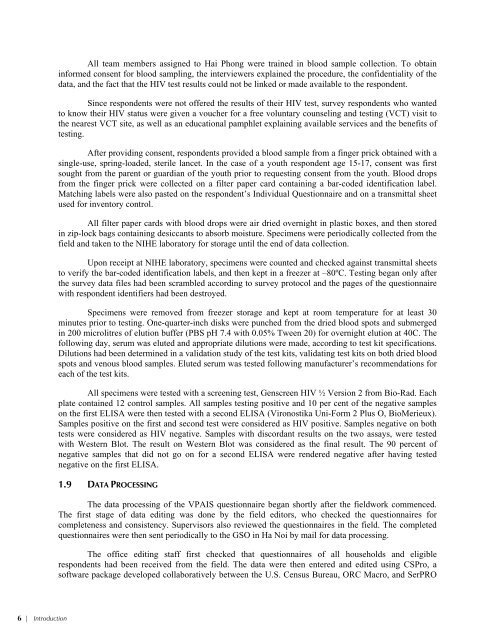Vietnam Population and AIDS Indicator Survey 2005 ... - Measure DHS
Vietnam Population and AIDS Indicator Survey 2005 ... - Measure DHS
Vietnam Population and AIDS Indicator Survey 2005 ... - Measure DHS
You also want an ePaper? Increase the reach of your titles
YUMPU automatically turns print PDFs into web optimized ePapers that Google loves.
All team members assigned to Hai Phong were trained in blood sample collection. To obtain<br />
informed consent for blood sampling, the interviewers explained the procedure, the confidentiality of the<br />
data, <strong>and</strong> the fact that the HIV test results could not be linked or made available to the respondent.<br />
Since respondents were not offered the results of their HIV test, survey respondents who wanted<br />
to know their HIV status were given a voucher for a free voluntary counseling <strong>and</strong> testing (VCT) visit to<br />
the nearest VCT site, as well as an educational pamphlet explaining available services <strong>and</strong> the benefits of<br />
testing.<br />
After providing consent, respondents provided a blood sample from a finger prick obtained with a<br />
single-use, spring-loaded, sterile lancet. In the case of a youth respondent age 15-17, consent was first<br />
sought from the parent or guardian of the youth prior to requesting consent from the youth. Blood drops<br />
from the finger prick were collected on a filter paper card containing a bar-coded identification label.<br />
Matching labels were also pasted on the respondent’s Individual Questionnaire <strong>and</strong> on a transmittal sheet<br />
used for inventory control.<br />
All filter paper cards with blood drops were air dried overnight in plastic boxes, <strong>and</strong> then stored<br />
in zip-lock bags containing desiccants to absorb moisture. Specimens were periodically collected from the<br />
field <strong>and</strong> taken to the NIHE laboratory for storage until the end of data collection.<br />
Upon receipt at NIHE laboratory, specimens were counted <strong>and</strong> checked against transmittal sheets<br />
to verify the bar-coded identification labels, <strong>and</strong> then kept in a freezer at –80ºC. Testing began only after<br />
the survey data files had been scrambled according to survey protocol <strong>and</strong> the pages of the questionnaire<br />
with respondent identifiers had been destroyed.<br />
Specimens were removed from freezer storage <strong>and</strong> kept at room temperature for at least 30<br />
minutes prior to testing. One-quarter-inch disks were punched from the dried blood spots <strong>and</strong> submerged<br />
in 200 microlitres of elution buffer (PBS pH 7.4 with 0.05% Tween 20) for overnight elution at 40C. The<br />
following day, serum was eluted <strong>and</strong> appropriate dilutions were made, according to test kit specifications.<br />
Dilutions had been determined in a validation study of the test kits, validating test kits on both dried blood<br />
spots <strong>and</strong> venous blood samples. Eluted serum was tested following manufacturer’s recommendations for<br />
each of the test kits.<br />
All specimens were tested with a screening test, Genscreen HIV ½ Version 2 from Bio-Rad. Each<br />
plate contained 12 control samples. All samples testing positive <strong>and</strong> 10 per cent of the negative samples<br />
on the first ELISA were then tested with a second ELISA (Vironostika Uni-Form 2 Plus O, BioMerieux).<br />
Samples positive on the first <strong>and</strong> second test were considered as HIV positive. Samples negative on both<br />
tests were considered as HIV negative. Samples with discordant results on the two assays, were tested<br />
with Western Blot. The result on Western Blot was considered as the final result. The 90 percent of<br />
negative samples that did not go on for a second ELISA were rendered negative after having tested<br />
negative on the first ELISA.<br />
1.9 DATA PROCESSING<br />
The data processing of the VPAIS questionnaire began shortly after the fieldwork commenced.<br />
The first stage of data editing was done by the field editors, who checked the questionnaires for<br />
completeness <strong>and</strong> consistency. Supervisors also reviewed the questionnaires in the field. The completed<br />
questionnaires were then sent periodically to the GSO in Ha Noi by mail for data processing.<br />
The office editing staff first checked that questionnaires of all households <strong>and</strong> eligible<br />
respondents had been received from the field. The data were then entered <strong>and</strong> edited using CSPro, a<br />
software package developed collaboratively between the U.S. Census Bureau, ORC Macro, <strong>and</strong> SerPRO<br />
6 | Introduction








![Obtaining Informed Consent for HIV Testing [QRS4] - Measure DHS](https://img.yumpu.com/49850117/1/190x245/obtaining-informed-consent-for-hiv-testing-qrs4-measure-dhs.jpg?quality=85)








